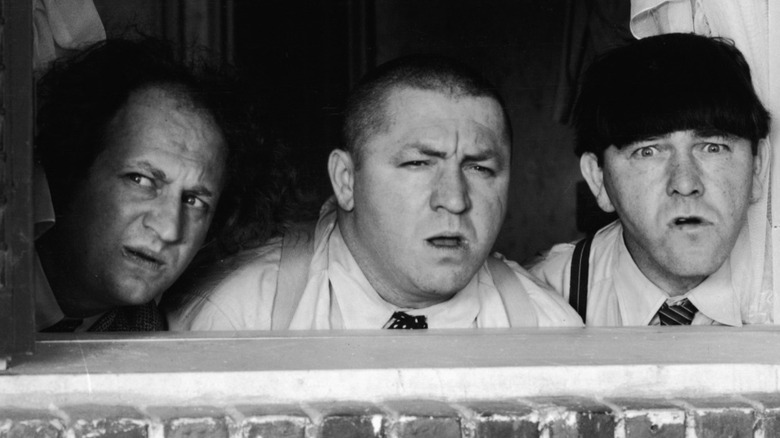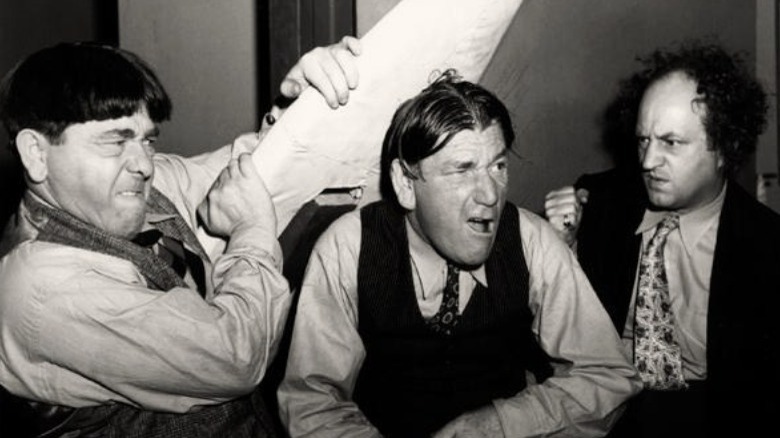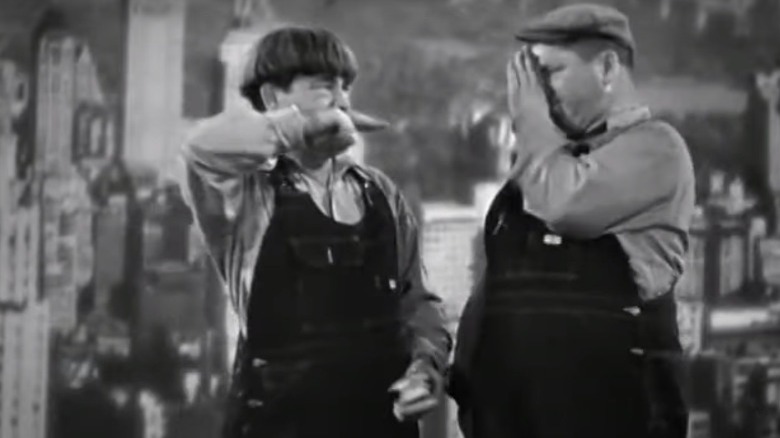Why Moe Can Thank Shemp For The Three Stooges' Signature Eye Poke
The physical comedy made popular by The Three Stooges often centered around the brutal violence that the players would impose upon each other. The trio would employ whatever was handy to inflict immediate pain on their foes, though they would more often victimize a fellow Stooge with moves that would maim or kill a person if performed in real life. Any nearby object became a weapon, especially common hand tools, as the Stooges would throw wrenches, strike with hammers, or cut with saws the flesh of countless people throughout nearly 200 film shorts (per IMDb). And when solid objects weren't to be found, the violent outburst of a Stooge (usually Moe) would be undertaken with the use of the hands. Belly punches, face slaps, and literal kicks-in-the-pants were only a few ways that a frustrated or angry Stooge would show displeasure.
The ways one Stooge would assault another are probably too many to count. But nearly a century later, there's a Stooge move that the trio will always be known for: the eye poke (an example is posted on YouTube). Performed scores of times, this painful-looking maneuver is the one most widely known by fans of the Stooges. But what many might not be aware of is that the history behind the classic Stooges eye poke assault was based on a real-life incident involving Moe, Larry, and Moe's older brother (and original Stooge) Shemp.
The eye poke was the result of a card game gone wrong
Many fans will consider the "classic" Stooge lineup to be Larry, Moe, and Curly. Shemp Howard (above, center) stepped in to replace Curly, who suffered a series of strokes in the late 1940s. But those who know their Stooge history remember that it was Shemp who performed with Moe and Larry first, touring the vaudeville circuit under the direction of Ted Healy ("Ted Healy and His Stooges"). After Shemp became frustrated with Healy's excessive drinking and abrasiveness, he left the act to pursue a solo career. This led Moe and Larry to bring in Curly to fill the spot, and it was Curley who filled out the trio when they leaped the short films that they will forever be known for (via GQ).
It was in those vaudeville days that an incident occurred that would forever change the Stooges act. While playing a friendly game of cards backstage, Shemp became convinced that Larry was cheating. In a rage, Shemp stood up and poked his fellow Stooge in the eyes with his two fingers. Moe, who witnessed the entire incident, took note of the move and would soon have it incorporated into their act (per Empire).
Though Shemp was attempting to harm his fellow Stooge, the eye poke that was employed on stage, and later on film, would require some sleight of hand so that the recipient wouldn't be injured. Rather than making contact with the eyes themselves, the aggressor (usually Moe) would angle the v-formation of his index and middle fingers up slightly so that both digits would make contact with the victim's eyebrows.
The eye poke move eventually had a block ... and a countermove to that block
The eye poke might have been the Stooges' most-used move, but it led to another running gag that would lead to a great addition to this popular bit. Over time, Curly and Larry figured out a way to block the flying vee of fingers that would rapidly jab at their eyeballs. Using one open hand, the recipient of Moe's ire could stave off the attack by placing it in front of the nose, vertically. With the palm facing perpendicular to the face, the pinky-side of the open hand would cause the two invading fingers to collide with it, stopping them just short of their targets. On some occasions, the fingers would be staved off by mop handles, shovels, or other objects clutched by the victim (amply demonstrated on YouTube).
The blocking technique would prove to be successful, but not for long. Eventually, a counter to the block would be incorporated into the act. While the victim would be gleefully celebrating foiling the eye poke attack, the aggressor (again, mostly Moe) would use the index finger on each hand to poke the eyes, going around the blocker's hand on either side (examples also on YouTube). The long-running gag demonstrated that a single bit could be used for laughs over and over again, while also showing that signature moves could be improved upon over time, becoming funnier as countermoves were developed.


